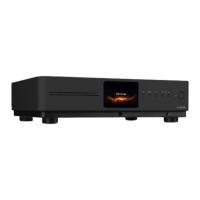
Do you have a question about the Audiolab Omnia and is the answer not in the manual?
| Type | Integrated Amplifier |
|---|---|
| Signal-to-Noise Ratio | >100dB (A-weighted) |
| Weight | 9.1 kg |
| Power Output | 50W per channel (8 ohms) |
| Frequency Response | 20Hz - 20kHz |
| Inputs | 1 x USB, 2x Coaxial, 2x Optical, 1 x Bluetooth |
| Outputs | 1 x Headphone |
| DAC | ESS Sabre ES9038Q2M |
| Connectivity | Ethernet, Wi-Fi, Bluetooth |
| Supported Audio Formats | MP3, AAC, WAV, FLAC |
Warnings regarding risk of electric shock, fire, and proper handling to prevent hazards.
Instructions on ensuring ventilation, avoiding heat sources, and proper grounding.
Information on fuse values and when to seek qualified service personnel.
Explanation of laser label, MQA, Bluetooth, aptX, and Roon Tested certifications.
Overview of the Omnia as an all-encompassing audio solution with integrated components.
Highlights the Omnia's features like CD playback, DAC, streaming, amplification, and connectivity.
Details the various analogue and digital input/output ports available on the unit.
Lists included items and provides instructions for positioning the unit for optimal performance.
Identification and function of buttons, indicators, and ports on the front and rear panels.
Explanation of different device states and Wi-Fi/Power LED meanings.
Instructions for inserting batteries and operating the remote control effectively.
Details on connecting analogue, phono, coaxial, and optical digital sources.
Information on pre-amplifier, loudspeaker, headphone outputs, and 12V trigger connections.
Instructions for Bluetooth pairing and connecting the AC power cord.
Adjusting DPLL bandwidth, operational modes, and display brightness.
Accessing display options and adjusting the audio output balance.
Adjusting the time for the display to revert to the home screen.
Configuring volume limits, trigger function, and auto standby features.
Resetting to defaults, selecting language, and checking firmware version.
How to switch sources, interpret LEDs, and understand playback indicators.
Selecting sources, viewing streaming services, and understanding operational modes.
Details on connection types and MQA/PCM audio format indicators.
How to access and cycle through various display modes like VU Digital and VU Analogue.
Procedure for switching the unit on/off and entering/exiting standby mode.
How to select input sources and adjust the volume level.
Using mute, configuring display settings, and understanding operating modes.
Explanation of the different operational modes for amplifier configuration.
Guide to accessing and navigating the menu pages for system customization.
Introduction to DTS Play-Fi capabilities for wireless streaming and multi-room audio.
Details on Surround Sound, Portable Listening, Rebroadcasting, A/V Sync, Wi-Fi, and Multi-Room.
Information on easy setup, Wi-Fi technology, and high-resolution audio support.
Instructions for obtaining the DTS Play-Fi APP from various app stores and websites.
Guide to connecting via Wired Ethernet or Wireless (WPS/Standard mode).
Step-by-step guide to connect the Omnia using the Play-Fi APP on mobile devices.
Instructions for setting up Wi-Fi via a web browser from a PC or Mac for advanced options.
Functions for CD loading, playback, pausing, stopping, and track selection.
How to select tracks, repeat play, and use random play modes.
Setting up programmed track sequences and playing music from a USB device.
List of compatible audio formats, sampling frequencies, and bit rates.
Guide to connecting the computer via USB for audio playback and driver information.
Controlling devices and accessing music services like Amazon Music, Deezer via Play-Fi APP.
Accessing Internet Radio and the Juke music streaming service through the APP.
Using KKBox and playing music stored on your device via the Play-Fi APP.
Streaming from media servers and using Sound Machine for background music.
Accessing music from Spotify and Napster streaming services.
Details on various music services like Pandora, Qobuz, QQMusic, and SiriusXM.
Using Tidal for high-fidelity music streaming with lossless audio quality.
Streaming audio inputs to other DTS Play-Fi devices for multi-room functionality.
Grouping Omnia and other devices for synchronized multi-room playback.
Creating Spotify groups and using the DTS Play-Fi Windows application.
Information on Surround Sound support and updating the system software.
Covers warranty duration, proof of purchase, and repair/replacement policies.
Lists specific conditions and damages not covered by the manufacturer's warranty.
Procedure for obtaining warranty service through authorized dealers or Audiolab.
Overview of the Omnia's integrated amplifier design and key technologies.
Detailed list of all available input and output connections on the Omnia unit.
Technical details for the preamplifier section and the Digital-to-Analog converter.
Specifications for the power amplifier section and supported sampling frequencies.
Technical details for the headphone amplifier, including distortion and impedance.
Includes power consumption, weight, dimensions, finish, and standard accessories.
Lists the minimum hardware and software requirements for installing the audiolab USB driver.
Step-by-step guide for installing the audiolab USB driver on various Windows operating systems.
Connect the USB device and verify the driver installation status for audio playback.
Configure the sample rate in the computer's sound control panel for optimal playback.
Download and install Foobar2000, SACD, and ASIO plugins for audio playback.
Set the output device, format, and ASIO driver mode in Foobar2000 preferences.
Access System Preferences and select the Audiolab USB Audio 2.0 Output device.
Open Audirvana Plus preferences and select the preferred audio device for playback.
Steps to resolve operational issues, including connection checks and power cycling.